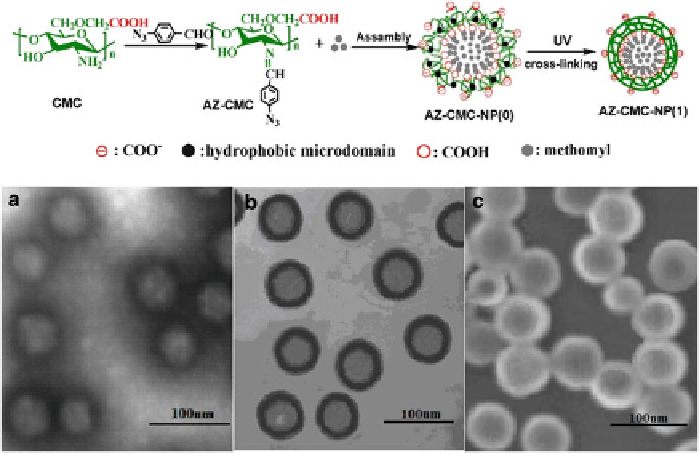Agriculture Reference
In-Depth Information
Fig. 5.5 Assembly process of methomyl-loaded shell cross-linked nanocapsules (
top
). TEM and
SEM images of methomyl-loaded nanocapsules on the basis of Az-CMCS-3 with an Az substitu-
tion degree of 0.23 in an aqueous solution at pH 4.0: (a) TEM of Az-CMCS-NP(0)-3 sample before
cross-linking, (b) TEM, and (c) SEM of Az-CMCS-NP(1)-3 sample after cross-linking (
bottom
)
(Sun et al.
2014
). Reproduced by permission of Elsevier
methomyl from the methomyl-loaded nanocapsules, the authors concluded that the
pesticide desorption was controlled by cross-linking of the shell, as well as by the
degree of cross-linking.
Other important agrochemical controlled release systems from polymeric matri-
ces were reported by various researchers (Mishra et al.
2004
; Xu et al.
2006
; Abedi-
Koupai et al.
2012
; Li et al.
2012
; Ma et al.
2013
; Melaj and Daraio
2013
; Saruchi
et al.
2013
; Yang et al.
2013
; Zhao et al.
2013
; Zhong et al.
2013
; Su et al.
2014
).
Notably, these systems were not nanostructured polymeric matrices but were
included due to the important concepts presented about the CR systems.
5.3.2 Hybrid Matrices
One of the pioneer studies utilizing hybrid matrices in the controlled release of
pesticides was conducted by Gerstl et al. (
1998
). In this paper, the release of
alachlor and atrazine pesticides from alginate and pectin polymeric matrices with
or without sodium montmorillonite and kaolinite inorganic nanoclays was studied.
It was observed that better results were achieved with the alginate-pectin blend. For
hybrid matrices formed by a nanoclay and alginate, it was possible to conclude that
the addition of the nanoclay to the alginate reduces the releasing of alachlor. The

